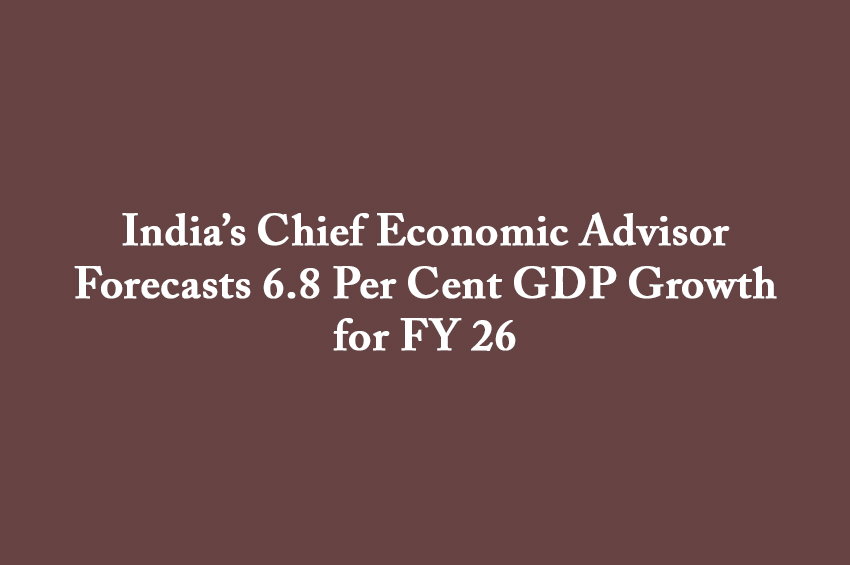Winning Bizness Economic Desk
India’s Chief Economic Advisor Forecasts 6.8 Per Cent GDP Growth for FY 26The country’s Chief Economic Advisor (CEA) Mr V Anantha Nageswaran has forecast a GDP growth rate of around 6.8 per cent for the current fiscal (FY 26).
This healthy growth rate is because of the higher consumption post GST and interest cuts, increase in private capex and higher Foreign Direct Investment (FDI) flows.
“I am now more comfortable looking at a number north of 6.8 per cent. My original number was 6.3 per cent-to-6.8 per cent, and back in August we were all concerned about whether we could even go towards the lower end of the band,” the CEA said at an event of a leading news outlet.
“But now there is a lot of comfort in saying that it will be definitely north of 6.5 per cent and I am more comfortable in saying even north of 6.8 per cent but whether I will raise the estimate to seven per cent, I would wait for Q2 numbers to come out,” he said.
Mr Nageswaran said that if India could strike a trade deal with the United States (US), the GDP growth could be even higher.
The US has imposed 50 per cent trade tariffs on India, among the highest globally.
The CEA said that it was the right set of legal and regulatory frameworks that enabled successes in some of the sectors.
For example, removing inverted duty structures and exempting primary and intermediate raw materials from customs duties has made the cost of production cheaper and more competitive, he said.
India’s Services Exports Touching USD 400-billion
The country’s services exports are now on course to cross the USD 400-billion mark for the first time ever. This, it must be pointed out here, could be achieved this financial year (FY 26) itself.
While performance of merchandise exports such as smart-phones and pharmaceuticals draws much public attention, services exports are often less talked about. However, their contribution to India’s economic progress has been growing significantly.
A point that needs highlighting here is that the country’s merchandise trade has always remained in deficit.
According to data from the Directorate General of Commercial Intelligence and Statistics in FY 25, the country exported goods worth USD 437.51-billion as against imports of USD 721.32-billion, resulting in a goods trade deficit.
In services, however, India exported USD 387.54-billion worth of services in FY 25, against imports of USD 198.14-billion, generating a services trade surplus of USD 189.40-billion, an all-time high.
This surplus offset nearly two-thirds of the merchandise trade deficit, bringing the overall trade deficit (goods plus services) down to USD 94.41-billion.
Over the past decade, India’s services trade surplus has steadily expanded from around USD 51-billion in 2011-12 to USD 65-billion in 2016-17, breaching USD 100-billion in 2021-22 and rising to USD 138-billion in 2022-23 besides touching nearly USD 190-billion now.
The earlier phase of India’s services trade was dominated by software and IT-enabled Services (ITeS). The real acceleration in recent years has come from Global Capability Centres (GCCs) of multi-nationals performing R&D, analytics, cyber-security, design and architecture in India.
Additionally, the growth in tech and professional services such as consulting, legal support, accounting and compliance has also supported the acceleration.
States’ Capex Likely Expanded 10 Per Cent in H1 FY 26
Capital expenditure by state governments likely expanded 10 per cent in the first six-months of the current fiscal (FY 26) on a shrunken base. This reflected a moderate growth as compared to the Centre’s front-loading of capex to boost economic activity.
Capex of 18 states in the April-to-September period increased to Rs 2.5-lakh-crore as compared to Rs 2.26-lakh-crore in the year-ago period, according to a review in a leading financial newspaper.
Here, it is important to note that these states’ capex had declined by nine per cent in the April-to-September period a year-ago due to election-related gaps.
The Centre’s capex climbed up steeply by 40 per cent on-year in the first-half of this fiscal (H1 FY 26) as compared to a 15 per cent on-year contraction in H1 FY 25.
Borrowing and other liabilities of the 18 states—Uttar Pradesh, Maharashtra, West Bengal, Madhya Pradesh, Odisha, Andhra Pradesh, Tamil Nadu, Gujarat, Haryana, Karnataka, Kerala, Telangana, Assam, Punjab, Rajasthan, Chhattisgarh, Jharkhand and Uttarakhand—moved northward 15 per cent on-year in the first-half of this fiscal to Rs 4-lakh-crore.
These states registered a nine per cent climb in their tax revenue in the first six-months of FY 26 at Rs 14.95-lakh-crore as compared to the 12 per cent growth recorded in the year-ago period.
The revenue expenditure of these states increased nine per cent to Rs 18.6-lakh-crore in H1 FY 26 as compared to Rs 17.2-lakh-crore in the year-ago period (up nine per cent on-year).
What requires highlighting here is that the Centre has budgeted to extend Rs 1.5-lakh-crore in 50-year interest-free capex loans to states in FY 26 for their capital projects.
The release of interest-free loans to states has accelerated in H1 FY 26.
Public capex—by the Centre, states and Central Public Sector Enterprises (CPSEs)—holds the key to the country’s fixed capital formation in recent years in the absence of strong private capex.
CPSEs and other central agencies, notably the railways and the National Highways Authority of India (NHAI) has witnessed a robust climb in capital expenditure during the first-half of this fiscal, with September alone clocking a huge 60 per cent expansion.
GJEPC Says Gems and Jewellery Exports Will Cross USD 100-bn by 2047
The Country’s gem and jewellery sector’s exports is likely to breach the USD 100-billion mark by 2047, transforming the country into a global hub. The sector, presently, contributes seven per cent to India’s merchandise exports.
The sector provides direct employment to over 42-lakh people pan-India besides contributing around USD 30-billion and USD 85-billion in exports and domestic sales, respectively.
This was stated by the Gem and Jewellery Promotion Council (GJEPC) Chairman Mr Kirit Bhansali.
He presented key policy recommendations aimed at upping exports and strengthening India’s manufacturing eco-system at a meeting in Delhi recently, chaired by Prime Minister Mr Narendra Modi.
The meeting also consisted of representatives of various industry sectors that contribute substantially to the country’s merchandise exports.
In order that the country remained globally competitive with leading trading centres such as the UAE, the US, Belgium and London, Mr Bhansali pointed out that India needed to establish an efficient and trade-friendly business environment.
The GJEPC Chairman requested the government to bring-in a special scheme offering export credit at concessional rates, particularly benefiting MSME units.
There was a need to hasten the passage of the SEZ Act amendment, the GJEPC said, so as to allow domestic sales with fair duty adjustment and enable optimal utilisation of idle capacity during off-season. This will help raise productivity, efficiency and employment stability, the organisation said.
Additionally, Mr Bhansali called for the formulation of a National Gem and Jewellery Park Policy similar to those existing for the leather and textile sectors to strengthen domestic manufacturing eco-systems and attract global investment into the sector.


